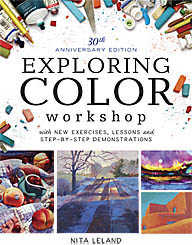Juried exhibition
Yesterday I went to the opening of the Dayton Society of Painters and Sculptors spring show. It was cold and blustery outside, but inside the 48 High Street Gallery it was warm and companionable. There was a fantastic crowd there for the opening of the show, but also to see recent renovations to the historic building housing the gallery. The exhibit space is elegant and a far cry from what it has been for many years. The show itself is very good, although a mixed bag with some works that aren't that good, in my opinion. I understand that nearly sixty artists entered the show, with many bringing the limit of three works. Around eighty-nine paintings were selected, so there were a lot of rejects.
One situation was particularly interesting. I wonder what you think of this. An artist entered a pastel diptych, but because together they were too wide for the limitations placed on entries, he entered them separately. One half got in the show and the other was rejected. The one that got in won a ribbon--third place, I think. The mat surrounded the entire diptych, so where the two pieces were to hang together, there was no mat. The three-sided mat looked a bit strange. The artist implied that the judge was weird to accept one and reject the other of two pieces of the whole. In my opinion, it was his fault for trying to evade the size limitation. In fact, if both had been accepted, it would have been the prerogative of the hanging committee to hang them separately if they wished, as they were entered individually.
I tend to be pretty strict about artists obeying the rules of a show. When I judge a show, I expect the committee to vet the work and remove anything that doesn't comply with their rules. Invariably, something comes up. In one show the artist used collage, which was specifically disallowed, but you couldn't tell it from the slide. When the piece arrived, it was not hung. In another show, an artist sent a colorful painting matted in black. Included was a note saying that she hoped this was okay, since black is a neutral. She knew full well that the prospectus meant white or off-white, but she also knew her painting would look better in a black mat. The committee caved and allowed the painting to hang. Interestingly, I've never seen this violation--a black mat--in any show, before or since, so I'm quite sure artists understand what is meant by "neutral" in the prospectus. As it happened, I knew that this artist had bent the rules in two other shows, so her claim that her husband had taken it to the framer and she didn't know until it was too late to change it rang hollow to me. The moral to this story is "follow the rules." It isn't fair to make committees and judges disqualify paintings when you already know they don't comply.
One situation was particularly interesting. I wonder what you think of this. An artist entered a pastel diptych, but because together they were too wide for the limitations placed on entries, he entered them separately. One half got in the show and the other was rejected. The one that got in won a ribbon--third place, I think. The mat surrounded the entire diptych, so where the two pieces were to hang together, there was no mat. The three-sided mat looked a bit strange. The artist implied that the judge was weird to accept one and reject the other of two pieces of the whole. In my opinion, it was his fault for trying to evade the size limitation. In fact, if both had been accepted, it would have been the prerogative of the hanging committee to hang them separately if they wished, as they were entered individually.
I tend to be pretty strict about artists obeying the rules of a show. When I judge a show, I expect the committee to vet the work and remove anything that doesn't comply with their rules. Invariably, something comes up. In one show the artist used collage, which was specifically disallowed, but you couldn't tell it from the slide. When the piece arrived, it was not hung. In another show, an artist sent a colorful painting matted in black. Included was a note saying that she hoped this was okay, since black is a neutral. She knew full well that the prospectus meant white or off-white, but she also knew her painting would look better in a black mat. The committee caved and allowed the painting to hang. Interestingly, I've never seen this violation--a black mat--in any show, before or since, so I'm quite sure artists understand what is meant by "neutral" in the prospectus. As it happened, I knew that this artist had bent the rules in two other shows, so her claim that her husband had taken it to the framer and she didn't know until it was too late to change it rang hollow to me. The moral to this story is "follow the rules." It isn't fair to make committees and judges disqualify paintings when you already know they don't comply.
Labels: exhibitions, oil painting





0 Comments:
Post a Comment
<< Home